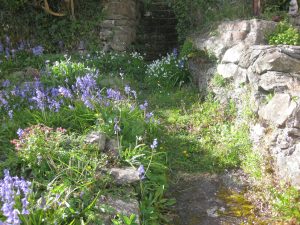
Bluebells and wild garlic in a Devonshire garden.
In Devon it is the bluebell season. Gardens and woodlands are tightly packed with them. They are beautiful, but also notorious because they can spread like weeds.
My favourite colour for bluebells is dark cobalt blue variety, but of course there are white, pink and lilac coloured ones as well. The cobalt blue-coloured ones seem to have a stronger perfume, but that may be my imagination.
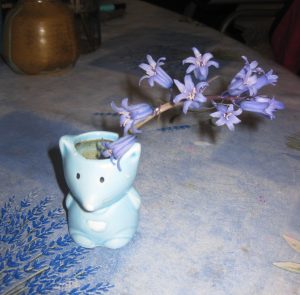
The scented variety of bluebell.
Although, traditional perfume manufacturers certainly include it in their scents (or should that be perfumes?). One such example is <https://www.penhaligons.com/uk/en/product/bluebell-000000000065161334>. You can identify if a bluebell is English or Spanish because the Spanish ones don’t have a scent.
In this part of Devon which is close to the border with Cornwall and the Tamar Valley <https://www.tamarvalley.org.uk/> it isn’t just the bluebell season but also the wild garlic season. So, if you are walking around this area and spot what appear to be bluebells growing in clumps quite often, they have wild garlic mixed in with them. The leaf shape is different, but at a distance wild garlic looks similar to white bluebells. Can you work out which are bluebells, and which are wild garlic from these photos?
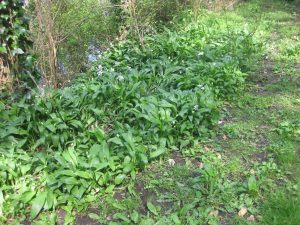
Wild garlic or white bluebells?
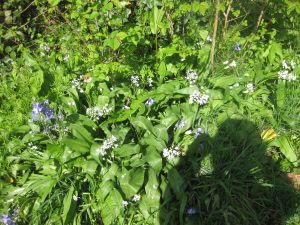
Wild garlic or white bluebells?
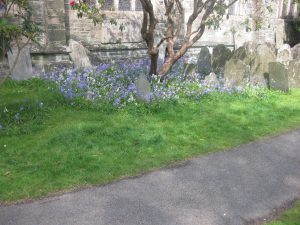
http://www.tavistockparishchurch.org.uk/
You are certainly in no doubt when you are out walking, because the smell of garlic on a warm day is overpowering and the subtle scent of the bluebell doesn’t stand a chance. It is possible to eat wild garlic, but not bluebells. As a rule of thumb as a child who would go scavenging on Dartmoor for whole days with friends armed with sandwiches and crisps, we were warned never to eat flowers that were blue as they were usually poisonous. <https://www.countryfile.com/how-to/food-recipes/wild-garlic-guide-where-to-find-how-to-cook-it-and-recipe-ideas/> and <https://en.wikipedia.org/wiki/Wild_garlic>.
Writer’s like Anne Bronte <https://allpoetry.com/poem/8457985-The-Bluebell-by-Anne-Bront%C3%AB> loved bluebells as this extract from her poem ‘The Bluebell’ illustrates:
“A fine and subtle spirit dwells
In every little flower,
Each one its own sweet feeling breathes
With more or less of power.
There is a silent eloquence
In every wild bluebell
That fills my softened heart with bliss
That words could never tell.
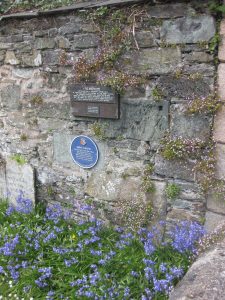
Bluebells in Tavistock
https://www.visit-tavistock.co.uk/
Other writers such as Gerard Manley Hopkins <https://en.wikipedia.org/wiki/Bluebell_wood> loved them as well, but as yet I haven’t discovered any odes to wild garlic. Perhaps one day I will discover one. there are poems that do mention wild garlic, but no odes and so until then we will just have to let chefs transform wild garlic into works of art through using it creatively in their recipes.
Of course, bluebells and bluebell lovers can be found all over the world as the article from a magazine published in New Zealand by Ray Stark one of the editors demonstrates. <https://happydiyhome.com/blue-bell-flower/>.